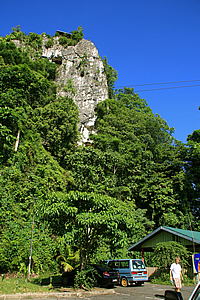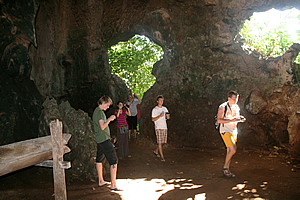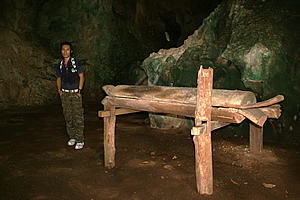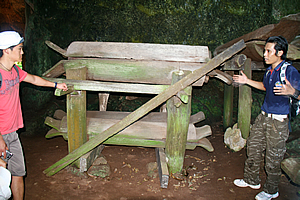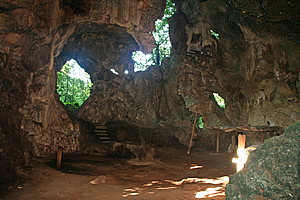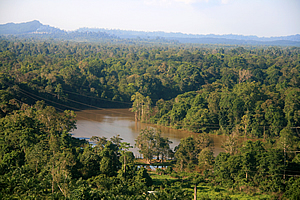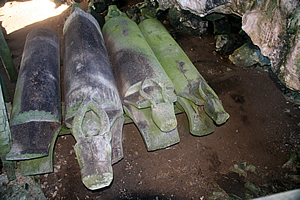--- Archive files ---
Home > Travels > Kinabatangan > 7 |
Tomb of the Chiefs above the Jungle
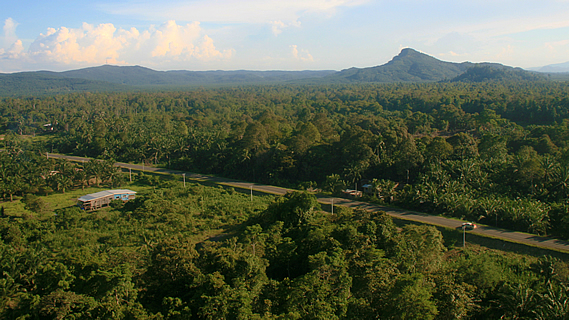
PEOPLE of high status in almost any civilisation were buried in an elaborate way. In some advanced cultures huge monuments were built for them. Even here the relatively primitive tribes of Borneo had their own elaborate way of burying their dead chiefs.
Limestone hill of tombs |
It was mid-afternoon when we were picked up from the village and taken about five kilometres away to the bottom of a towering limestone bluff. Our tour leader Richard didn’t come with us. He had been there numerous times before and had decided that it was far too hot for him. Siamet, our guide from the Kinabatangan River led us from the car park up a very steep set of stairs into the shade of the lush small trees growing in the crevices of the bluff. He assured us that at just forty five metres high, the hill was one ninetieth of the height of Mount Kinabalu. He said that if we could climb Kinabalu, then we would be able to climb this bluff with ease.
We climbed the steep stairway to dizzying heights to the top of the staircase about half way up the bluff. From there we followed a reasonably level narrow dirt track around a ledge precariously perched to the cliff face. We followed it for about ten metres before turning into a narrow crevice at the bottom of a large hole in the wall leading into a cave.
Insise the cave half way up the hill |
The cave was surprisingly big given the small size of the bluff. There were several window entrances to the cave. One of which we had just come through. There was a much larger one that had stairs leading up to the exit. The other cave windows were a bit higher up off the ground. I was amazed that the obviously thin walls would still be able to hold up another twenty plus metres of rock above the ceiling. Well it hadn’t collapsed yet after thousands of years of erosion, so it would be almost impossibly unlikely that it would collapse on us this calm day.
Log sarcophagus |
I looked up around the fawn brown ceiling. It seemed to be moving. Then I realised there were hundreds of small bats perched up there in the process of stirring for the approaching evening. It was desperately hot in here, but they must be used to that by now.
There were wooden machines inside the cave, along with several sarcophaguses carved out of timber logs. They would have been very heavy and hard to move under any terrain. It would have therefore taken a phenomenal amount of effort to have brought them way up here especially in the absence of the modern stairs we had climbed today. Each sarcophagus was sitting about a metre off the ground on a large H frame of raw timber at either end. The guide droned on about the cave, and the indigenous people who lived in this area. Most people were buried in regular graves in the jungle, but the tribal chiefs were buried here. Once finished, we headed up the stairway up through the opening on the other side of the cave.
Log sarcophagus |
We stopped just outside the main cave where there were several log coffins set up on log frames. Some of the sarcophaguses were about twenty centimetres off the ground and others were about one and a quarter metres above the ground, elevated with the H frames. He explained some of the very wealthy were buried here several hundred years ago. No one knows how these very heavy coffins had been raised so high on such a steep hill. The stairs we had climbed were built very recently, so it would have been a very difficult climb even without the very heavy coffins. The indigenous Orang Murut Dusun people here certainly weren’t known for any construction skills that made the Romans or Inca famous. Their tools and construction methods were very basic by any standards.
The cave |
We returned through the main cavern and through the keyhole entrance back along the dirt track along the ledge to the staircase we had climbed. The staircase continued up the steep cliff, in some places suspended in the air. The stairs were broken only by a natural rock formation channel which we walked up for about two metres to a continuation of the stairway. We slowly climbed them breaking away from the vertical bluff for a few metres to have a clear view of the landscape below us. We continued climbing until eventually reaching a large gazebo atop the summit of the bluff.
River from the summit |
From here we could see the village and the river, and the area where the eco lodge was. There were several small ancient hills covered in forest. It was a very exotic landscape reminding me of the landscape around Angkor in the heart of Cambodia. Here it was more hilly with the Kinabatangan River meandering through the dense forest below us.
I could see the bridge over the river and the village underneath it in the distance, nestled in amongst the forest beside the meandering river almost completely hidden. I recognised the big bluff on the other side of the river creating a nice backdrop to the village. Lopsided jagged limestone hills broke the landscape. The hills were all forested apart from the occasional vertical grey bluff typical in limestone country.
Here we rested, having reached the summit. Obviously it was a much easier summit than Kinabalu, but certainly nothing to write home about.
More tombs in the upper cave |
We followed another steep staircase down the other side of the hill, dropping about ten metres to another cave. To our surprise there were more sarcophaguses here rather tightly packed in the confined space. A couple of long poles of wood helped to hold up the cave ceiling. Siamet once more spoke at great length about the history of the cave explaining the people buried up here in this cave were royalty. The coffins had bulls heads carved in them of a much higher standard than the crocodile ones below. The heads were smoothly carved including the horns swept back. Once he was finished talking, we continued downstairs all the way to the bottom. It was quite a slow climb down the steep hill, and it was a relief to finally be at the bottom.
The old chiefs of the local Murat Dusun people lie resting in peace in the high caves overlooking the lands and jungles where they had ruled during their lifetimes.
<< Previous | Next >> |
|
||
About this Page
|
||
|
|
|
Where is Walkabout Jeff? |
|
|
|
|
What is happening in Walkabout Jeff's hometown?
|
|
|
|
|
Who is Walkabout Jeff?Any normal person's idea of going out involves going to the local pub for a drink with a few mates. Walkabout Jeff isn't normal.
|
|
|
|
|
